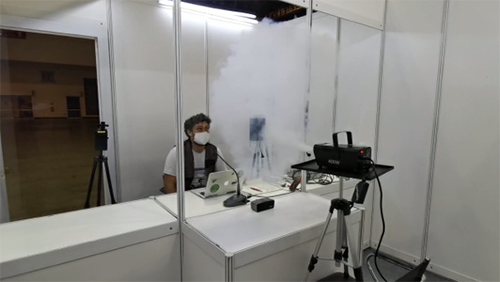Scientific studies by researchers in Singapore on the efficacy of COVID-19 mitigation measures
18 May 2021 | Tuesday | News

Overview of preventive measures to reduce fomites, droplet and aerosol transmission
A*STAR has worked together with the local research ecosystem , including Temasek Foundation, Temasek Life Sciences Laboratory, Institutes of Higher Learning (IHLs) and various public agencies, on scientific studies that examine the efficacy of various COVID-19 environmental mitigation measures. These include ventilation in spaces, air filters, air ionisers, table-top dividers, and UVC lights, among others.
On top of current safe management measures such as wearing of masks, maintaining safe distancing, limiting social contacts and observing good personal hygiene, these additional solutions will help support a safer resumption of activities in Phase 3 as the nation continues to reopen in phases.
Businesses, organisations, as well as families and individuals can explore such insights and customised solutions that best fit their needs and circumstances at work, at play or at home, to supplement the current safe management measures.
VENTILATION IN SPACES TO REDUCE DROPLET AND AEROSOL TRANSMISSION
In an earlier study, A*STAR researchers, together with SingHealth doctors from the SGH Department of Infectious Diseases; and the Department of Respiratory and Critical Care Medicine, have demonstrated the importance of wearing a mask.
A*STAR researchers have since developed a computational fluid dynamics framework which accurately models the spread of droplets when a person with COVID-19 coughs in Singapore's tropical environment.

Droplet dispersion from a single cough for two persons spaced 1 m apart.
This is the first study that accurately models the characteristics of large cough droplets which evaporate partially, leaving behind smaller droplets which can then be carried even further by the wind. The findings revealed that a 100 micrometre (µm) cough droplet can travel up to 6.6m at a wind speed of 2m/s, if the person who coughs is not wearing a mask.
The simulations done by the team at A*STAR’s Institute of High Performance Computing (IHPC), take into account factors found in Singapore’s climate, such as wind, temperature and humidity levels. The findings showed the spread of droplets and aerosols are greatly dependent on environmental conditions, hence there are different risk levels for different venues, which require different mitigation measures to ensure events can take place safely.

IHPC’s simulation and modelling of cough droplets in an indoor theatre.
The simulations derived through the crunching of multiple variables and complex equations using resources at the National Supercomputing Centre, Singapore (NSCC), produced highly accurate results that depict the paths of droplets, to help advise the design of safe management measures. Read more in this scientific paper.
"Our research has shown scientific proof that it is very important to wear a mask, practise good personal hygiene and social distancing, and ensure the environment is well ventilated, as all these things help to collectively lower the risk of transmission." said Dr Lim Keng Hui, Executive Director of A*STAR’s Institute of High Performance Computing.

IMRE’s experimental setup to study the flow of droplets and aerosols.
Apart from the computer simulations, there were also physical studies designed by scientists from A*STAR’s Institute of Materials Research and Engineering (IMRE). The team used aerosol generators, laser beams and sensitive high-speed cameras to study the physical effects of airflow and the spread of droplets in real life.
"We have been working with the public agencies, the business owners, as well as venue operators to come up with science-based recommendations which will enhance mitigation measures and help reduce the cases of transmission," said Prof Loh Xian Jun, Executive Director of A*STAR’s Institute of Materials Research and Engineering.

Scientists from IMRE analysed the risk levels of different exhibition booth designs in experiments which simulated the movement of droplets and aerosols. A booth design with full plexi-glass barrier is shown here.
The combination of IHPC’s computational modelling expertise and IMRE’s experimental design and particle sensing capabilities allowed the teams to cross-validate the findings, and quantify potential aerosol exposure levels in different settings and social distancing, such as in public spaces.
Read more here : Did you know: the science behind COVID-19 environmental mitigation (a-star.edu.sg)
Most Read
- Top 25 Biotech & Biopharma Leaders in Sustainable Innovation, 2025
- China’s Biopharma Dealmaking Surges in H1 2025, Driven by Record Licensing and Oncology Focus
- Chikungunya in China: How a “Forgotten” Arbovirus Found the Perfect Storm
- How Innovation Gaps in Biopharma Raise New Safety Concerns
- Smart Implants and the Future of Musculoskeletal Injury Treatment
- How Ethical Gaps in Psychiatry Could Undermine Biopharma Progress
- The Evolving Landscape of Women’s Health Innovation in the Asia-Pacific
- Using NLP-Driven Decision Support in Emergency Health Assistance
- Taiwan Steps Into the Global Spotlight With a New Cancer Therapy
- The Role of Unique Device Identification (UDI) in Tracing Medical Device Safety
- The Importance of a Patient’s Mental Health During Clinical Trials
Bio Jobs
- The State of Biotech and Life Science Jobs in Asia Pacific – 2025
- Avantor’s New CEO Ligner Aims to Unlock Global Potential and Deliver Shareholder Value
- AstraZeneca Commits $50 Billion to U.S. Expansion by 2030 in Biggest-Ever Global Investment
- Thermo Fisher, SAMRC, and South Africa’s Department of Science and Innovation Launch CATIR to Nurture Next-Gen Scientists
- Cube Biotech Appoints Former Sartorius CEO Dr. Joachim Kreuzburg to Board of Directors
- FDA’s AI Transition Marks a Turning Point in Drug Review: Industry Faces Pressure to Adapt Amid 20% Workforce Cut
- WuXi XDC Completes Mechanical Build of Singapore Bioconjugate Manufacturing Hub
News
Editor Picks











